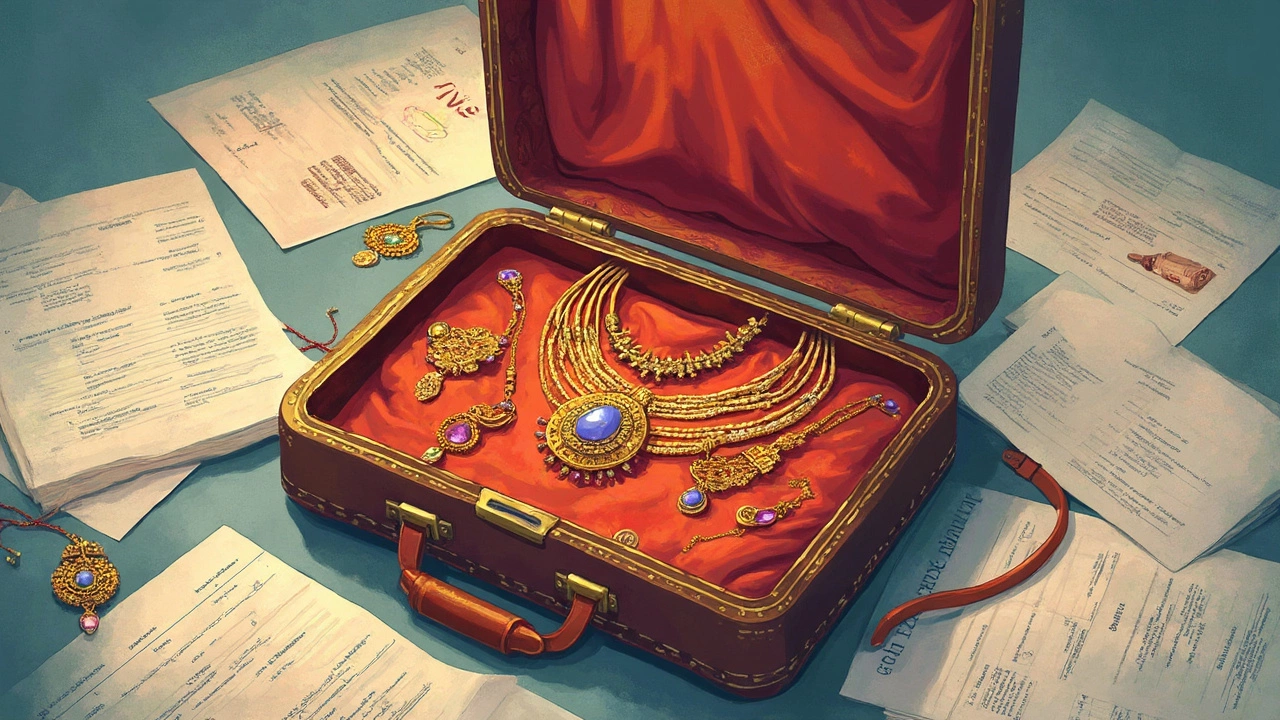
Traveling to India with jewelry? You might be picturing strict customs officials and lengthy forms, and honestly, no one wants that hassle. So, what's the deal with declaring your shiny stuff at Indian customs? Understanding this can save you a headache—or worse, a customs fine.
First things first, if you're carrying jewelry into India, there's a chance you'll need to declare it. But not all pieces are treated the same. Typically, jewelry above a certain value—or if it seems like you're importing it for more than just personal use—needs to be declared. Knowing what's required can prevent any hiccups on your journey.
- Understanding Indian Customs Regulations
- What Jewelry Needs Declaring
- Tips for Safely Traveling with Jewelry
- Temple Jewelry: Special Considerations
- Navigating the Customs Process
Understanding Indian Customs Regulations
When it comes to bringing jewelry into India, understanding customs regulations is key. No one wants a nasty surprise at the airport! The primary rule is that any jewelry you bring in may need to be declared, particularly if it has significant value. But let's break this down further.
For Indian customs, moving personal items through their system involves knowing the limits. As a tourist, you can bring in goods worth up to INR 50,000 without paying customs duty. However, high-value items, especially jewelry, may exceed this limit easily. So, if your bling crosses this threshold, you're expected to declare it. It's not about being stingy, but more about ensuring that everything's above board.
Moreover, when we talk about temple jewelry, which tends to have cultural and artistic significance, it's wise to clarify this with customs officials upon landing. The design intricacies often mean a higher price tag, meaning these pieces might be scrutinized more closely.
Be prepared with receipts or appraisals that establish how much your jewelry is worth. Having these documents ready is like carrying a customs pass. This is super helpful if you need to establish your jewelry's value, proving it isn't commercial cargo. To keep this process smooth and easy, here's a quick checklist:
- Have all receipts or jewelry appraisals on hand.
- Make sure your jewelry is well-packaged and easily presentable.
- Know the INR 50,000 threshold and assess if you're above it.
Navigating Indian customs isn't too daunting if you know the rules. With a bit of prep, you can sail through without a hitch, ensuring your valuables stay safe and sound.
What Jewelry Needs Declaring
When stepping off the plane in India with your precious items, it's tempting to breeze through customs without a second thought. However, it's essential to know what jewelry you need to declare. Generally, if you're wearing or carrying jewelry for personal use within reasonable quantities, you're in the clear. But there's a twist.
If your jewelry is made of gold, you might hit a snag. India has specific rules for gold imports, so if you're carrying more than 20 grams for a female traveler or 50 grams for a male, you'll likely need to declare it, especially if the value exceeds INR 50,000 for men and INR 100,000 for women. For temple jewelry, which can be quite valuable, these numbers are crucial.
To make things more straightforward, here's a quick checklist of what could require declaration:
- Gold jewelry exceeding the standard weight allowances.
- Items that are obviously for resale and not for personal use.
- Jewelry that looks commercial, like a large number of similar items.
- Any precious stones if they form a significant part of the jewelry.
Make sure to keep receipts or proof of purchase to justify the value of your jewelry. If you're transporting extraordinary pieces, it might be worth documenting them before you travel. Having photos or appraisals can help if you're asked to prove authenticity or value at customs.
In short, carry what's personal, declare what might raise eyebrows, and always err on the side of transparency. Better safe than sorry, right?

Tips for Safely Traveling with Jewelry
Traveling with valuable jewelry can feel a bit nerve-wracking. Who wants to lose their beloved temple jewelry or deal with customs headaches? Here are some practical tips to keep your treasures safe and sound.
Insure Your Jewelry: Before heading off, check if your travel insurance covers jewelry. Some plans don't, and having separate coverage can be a lifesaver if something goes wrong.
Carry It On: Always keep your jewelry in your carry-on luggage. Don’t leave it to the whims of checked baggage handlers. With your eyes on it, the risk of loss or theft drops dramatically.
Document Everything: Photograph each piece of jewelry before you pack it. This helps with identification if something gets misplaced and can streamline the process if you need to make a claim.
- Valuable Records: Along with photos, keep receipts or appraisals. If customs officials ask for proof of purchase, you’ll be ready.
- Minimalism is Key: Only take the essential pieces you'll wear. The less you carry, the less you worry about.
Secure Storage: Once in India, use the hotel safe instead of leaving valuables in your room. Most reputable places offer this service without a hitch.
Know the Local Laws: Familiarize yourself with Indian customs regarding jewelry. This can vary, and knowledge here keeps you from unwittingly making mistakes.
With these tips, you can enjoy your trip knowing your cherished jewelry is under control. Safe travels!
Temple Jewelry: Special Considerations
When it comes to temple jewelry, there are a few more things to think about. This type of jewelry isn’t just about bling; it’s deeply tied to Indian culture and religion. Designed with intricate details and often used for deities in temples, these pieces are not only valuable in terms of money but also heritage. So, what should you know before bringing temple jewelry into India?
If you’re packing some temple jewelry, it's crucial first to understand its value, both financially and culturally. The higher the value or the more significant its cultural importance, the more likely you'll have to declare it at customs.
To ensure everything goes smoothly:
- Verify Documentation: Have all your papers ready. This includes purchase receipts and any certifications of authenticity. Being able to show these can make the customs process easier.
- Insurance: Make sure your temple jewelry is insured. This not only covers you in case of loss but also provides an additional verification layer if questions arise at customs.
- Photographic Evidence: Having pictures of your jewelry, especially showing any unique details or hallmarks, can be a huge help if customs officials want to inspect it.
At Indian customs, they may ask specific questions about the use of the jewelry. Explaining that it’s for personal celebrations or religious occasions can make a difference.
For those curious about the value stats, consider this: significant pieces of temple jewelry can range from a few thousand to tens of thousands in value. Having a reliable appraisal is a good idea.
When you’re informed and prepared, carrying precious temple jewelry doesn't have to be nerve-wracking. Just remember to respect the cultural and historical significance of these pieces while enjoying their beauty.

Navigating the Customs Process
So you've landed in India with your precious jewelry, and now it's time to face the customs. Don't sweat though; here's a step-by-step guide to make it a breeze:
- Prepare Your Paperwork: Before you land, make sure you've got receipts or appraisals ready. These documents help customs officials quickly see that your jewelry isn't worth more than you're allowed to carry without duty.
- Fill Out the Declaration Form: On your flight, you'll receive a customs declaration form. Be honest and accurate. If your jewelry crosses the threshold for free allowance, write it down. It's way better than trying to hide it.
- Head to the Red Channel: Once at customs, if you're declaring jewelry, you'll go through the 'Red Channel.' It's where they handle declarations. Have your documents ready and present them confidently.
- Answer Questions: You might get some questions about why you're bringing in your jewelry, especially if it's temple jewelry. Be straightforward—tell them it's for personal use or a family function.
- Pay Duties if Required: If your items exceed the exempt value, you'll need to pay some duties. Make sure you've got a bit of cash or a credit card ready, just in case.
Here’s a little cheat sheet:
| Item Type | Duty-Free Limit (INR) |
|---|---|
| Gold Jewelry | 50,000 (for male travelers) |
| Gold Jewelry | 100,000 (for female travelers) |
Remember, it's not just about getting through customs; it's about protecting your belongings too. By following the rules and staying upfront, you help ensure your jewelry remains safe and sound throughout your journey. Nobody wants to deal with fines or confiscations!


